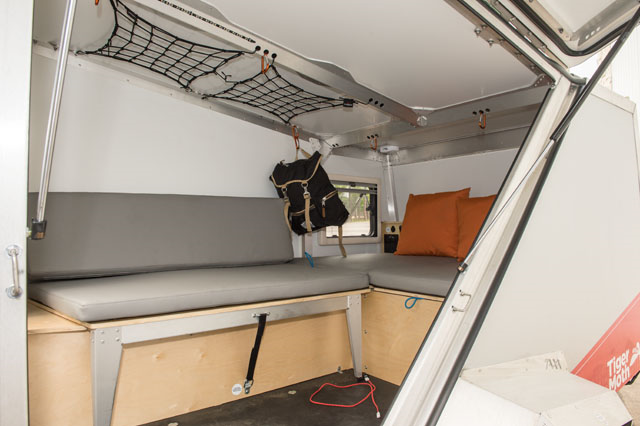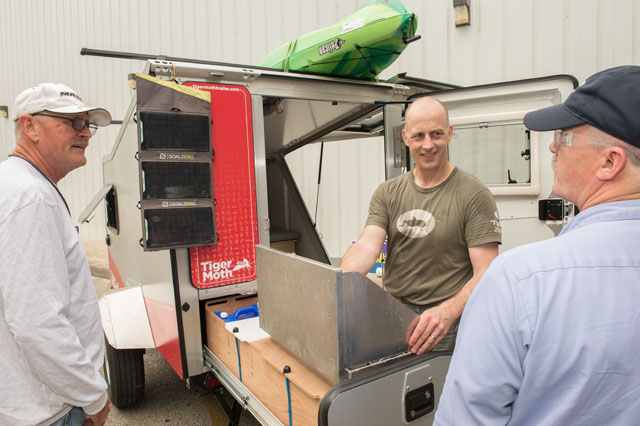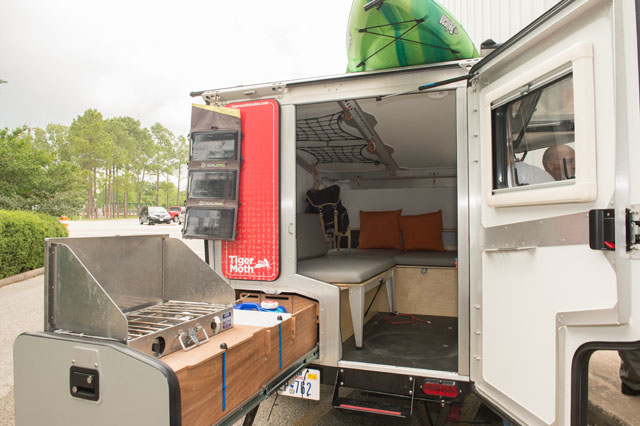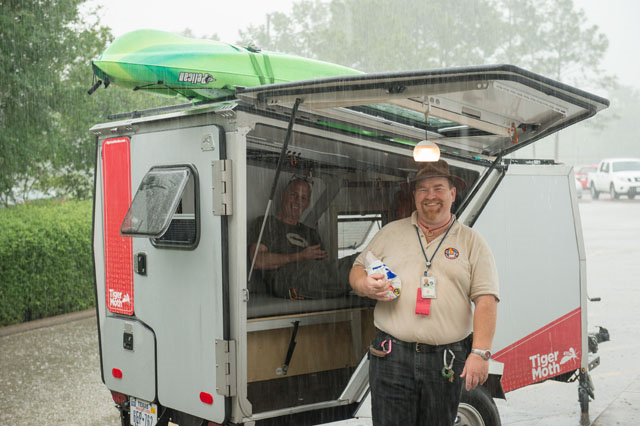From off the Earth to off the grid
2016-04-26
If you attended the Spring Safety, Health and Environment Fair on April 20, you may have noticed a small insect sitting next to the free hotdogs. This small insect was, in fact, a TigerMoth trailer, a tiny camping trailer designed to sleep two adults. The TigerMoth is the smaller cousin to the original Cricket trailer, the brainchild of Garret Finney, an award-winning architect who collaborated with NASA in 1999 to design the habitat for a new space station.
The International Space Station (ISS) has as much interior space as a five-bedroom house, but it’s packed with equipment, science experiments, exercise gear and Robonaut, the seventh crew member.
All of these components are built to strict performance guidelines to operate in the harsh environment of low-Earth orbit. In the midst of all that, providing visual and physical space for aesthetics and personal needs can be a difficult challenge.
Finney used his architectural expertise to remove irritations from the astronauts’ living and working spaces. Whether it was considering the difference an inch of width makes, finding a place for personal photos or substituting toeholds for chairs, Finney kept in mind the need for creature comforts in a cramped environment.
Finney said of his collaboration with NASA, “I’ve never worked in such a diverse environment where people are excited every day about what they’re doing.”
Later, Finney leveraged his NASA experience to bring the best of space station living down to Earth and founded Cricket, an outdoor equipment company. If you call his trailer an RV, however, he’s quick to correct you.
“The RV paradigm is houses on wheels,” Finney said. “Cricket is creating outdoor equipment where you can sleep off the ground.”
Each design element in the trailers is filtered through Finney’s NASA experience. Hooks, nets and attach points are built into the ceiling and walls. The mini-kitchen slides under the bed when not in use. Plentiful windows provide cross-ventilation and panoramic views. Pull-down berths can be used as children’s beds or temporary storage.
“People go camping to have a different experience,” Finney said. “We want you to leave your house at home.”
One of Finney’s primary goals is to get more people out into the wilderness. Integrated electrical and plumbing systems can support the trailers for up to three days of off-grid camping.
Finney also deliberately designed his trailers to be extremely lightweight and maneuverable. The TigerMoth weighs just 900 pounds. The larger Cricket weighs 1,460 pounds and can be towed by a typical four-cylinder passenger car. The smaller designs mean a smaller footprint on the Earth.
“To be better stewards of our national parks, we need to go see them and fall in love with them again,” Finney said. “We need to be inspired to be light on the land and part of the big ecosystem instead of pretending the parks are just postcards for looking at.”
Walt Ugalde of Johnson Space Center’s Technology Transfer and Commercialization Office said, "For NASA, we all understand that technology drives exploration. Finney’s adaptation of experiences gained through ISS human factors capabilities are a perfect example of ‘off the Earth, for the Earth.’ It’s a perfect complement to Earth Day."
Michelle Fraser-Page
NASA Johnson Space Center
The International Space Station (ISS) has as much interior space as a five-bedroom house, but it’s packed with equipment, science experiments, exercise gear and Robonaut, the seventh crew member.
All of these components are built to strict performance guidelines to operate in the harsh environment of low-Earth orbit. In the midst of all that, providing visual and physical space for aesthetics and personal needs can be a difficult challenge.
Finney used his architectural expertise to remove irritations from the astronauts’ living and working spaces. Whether it was considering the difference an inch of width makes, finding a place for personal photos or substituting toeholds for chairs, Finney kept in mind the need for creature comforts in a cramped environment.
Finney said of his collaboration with NASA, “I’ve never worked in such a diverse environment where people are excited every day about what they’re doing.”
Later, Finney leveraged his NASA experience to bring the best of space station living down to Earth and founded Cricket, an outdoor equipment company. If you call his trailer an RV, however, he’s quick to correct you.
“The RV paradigm is houses on wheels,” Finney said. “Cricket is creating outdoor equipment where you can sleep off the ground.”
Each design element in the trailers is filtered through Finney’s NASA experience. Hooks, nets and attach points are built into the ceiling and walls. The mini-kitchen slides under the bed when not in use. Plentiful windows provide cross-ventilation and panoramic views. Pull-down berths can be used as children’s beds or temporary storage.
“People go camping to have a different experience,” Finney said. “We want you to leave your house at home.”
One of Finney’s primary goals is to get more people out into the wilderness. Integrated electrical and plumbing systems can support the trailers for up to three days of off-grid camping.
Finney also deliberately designed his trailers to be extremely lightweight and maneuverable. The TigerMoth weighs just 900 pounds. The larger Cricket weighs 1,460 pounds and can be towed by a typical four-cylinder passenger car. The smaller designs mean a smaller footprint on the Earth.
“To be better stewards of our national parks, we need to go see them and fall in love with them again,” Finney said. “We need to be inspired to be light on the land and part of the big ecosystem instead of pretending the parks are just postcards for looking at.”
Walt Ugalde of Johnson Space Center’s Technology Transfer and Commercialization Office said, "For NASA, we all understand that technology drives exploration. Finney’s adaptation of experiences gained through ISS human factors capabilities are a perfect example of ‘off the Earth, for the Earth.’ It’s a perfect complement to Earth Day."
Michelle Fraser-Page
NASA Johnson Space Center

TigerMoth Trailer at the 2016 Spring Safety, Health and Environment Fair. Image Credit: NASA/Lauren Harnett

TigerMoth Trailer at the 2016 Spring Safety, Health and Environment Fair. Image Credit: NASA/Lauren Harnett

TigerMoth Trailer at the 2016 Spring Safety, Health and Environment Fair. Image Credit: NASA/Lauren Harnett

TigerMoth Trailer at the 2016 Spring Safety, Health and Environment Fair. Image Credit: NASA/Lauren Harnett







